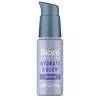What's inside
What's inside
 Key Ingredients
Key Ingredients

 Benefits
Benefits

 Concerns
Concerns

 Ingredients Side-by-side
Ingredients Side-by-side

Water
Skin ConditioningStearyl Alcohol
EmollientCaprylic/Capric Triglyceride
MaskingButyrospermum Parkii Butter
Skin ConditioningGlycerin
HumectantCetearyl Alcohol
EmollientGlyceryl Caprylate
EmollientCetyl Alcohol
EmollientCeramide NP
Skin ConditioningCeramide AP
Skin ConditioningCeramide EOP
Skin ConditioningPhytosphingosine
Skin ConditioningCholesterol
EmollientCalendula Officinalis Flower Extract
MaskingNiacinamide
SmoothingAvena Sativa Kernel Flour
AbrasivePalmitoyl Hexapeptide-19
Skin ConditioningAlthaea Officinalis Leaf/Root Extract
EmollientSodium PCA
HumectantSodium Lactate
BufferingArginine
MaskingAspartic Acid
MaskingPCA
HumectantGlycine
BufferingAlanine
MaskingSerine
MaskingValine
MaskingProline
Skin ConditioningThreonine
Isoleucine
Skin ConditioningHistidine
HumectantPhenylalanine
MaskingGlyceryl Stearate Citrate
EmollientSodium Lauroyl Lactylate
EmulsifyingXanthan Gum
EmulsifyingPhenoxyethanol
PreservativeEthylhexylglycerin
Skin ConditioningPlant Ash
Water, Stearyl Alcohol, Caprylic/Capric Triglyceride, Butyrospermum Parkii Butter, Glycerin, Cetearyl Alcohol, Glyceryl Caprylate, Cetyl Alcohol, Ceramide NP, Ceramide AP, Ceramide EOP, Phytosphingosine, Cholesterol, Calendula Officinalis Flower Extract, Niacinamide, Avena Sativa Kernel Flour, Palmitoyl Hexapeptide-19, Althaea Officinalis Leaf/Root Extract, Sodium PCA, Sodium Lactate, Arginine, Aspartic Acid, PCA, Glycine, Alanine, Serine, Valine, Proline, Threonine, Isoleucine, Histidine, Phenylalanine, Glyceryl Stearate Citrate, Sodium Lauroyl Lactylate, Xanthan Gum, Phenoxyethanol, Ethylhexylglycerin, Plant Ash
Water
Skin ConditioningButylene Glycol
HumectantGlycerin
HumectantTriheptanoin
Skin ConditioningHydrogenated Ethylhexyl Olivate
EmollientSorbitol
HumectantPanthenol
Skin ConditioningAcrylates/C10-30 Alkyl Acrylate Crosspolymer
Emulsion StabilisingMica
Cosmetic ColorantHydroxyethyl Acrylate/Sodium Acryloyldimethyl Taurate Copolymer
Emulsion StabilisingHydroxyacetophenone
AntioxidantInulin
Skin ConditioningPolyisobutene
Tocopheryl Acetate
AntioxidantHydrogenated Olive Oil Unsaponifiables
EmollientPEG-7 Trimethylolpropane Coconut Ether
EmulsifyingTetrasodium Glutamate Diacetate
Sodium Hydroxide
BufferingSorbitan Isostearate
EmulsifyingSodium Hyaluronate
HumectantCocos Nucifera Oil
MaskingLeuconostoc/Radish Root Ferment Filtrate
AntimicrobialPhenoxyethanol
PreservativeCI 77891
Cosmetic ColorantWater, Butylene Glycol, Glycerin, Triheptanoin, Hydrogenated Ethylhexyl Olivate, Sorbitol, Panthenol, Acrylates/C10-30 Alkyl Acrylate Crosspolymer, Mica, Hydroxyethyl Acrylate/Sodium Acryloyldimethyl Taurate Copolymer, Hydroxyacetophenone, Inulin, Polyisobutene, Tocopheryl Acetate, Hydrogenated Olive Oil Unsaponifiables, PEG-7 Trimethylolpropane Coconut Ether, Tetrasodium Glutamate Diacetate, Sodium Hydroxide, Sorbitan Isostearate, Sodium Hyaluronate, Cocos Nucifera Oil, Leuconostoc/Radish Root Ferment Filtrate, Phenoxyethanol, CI 77891
 Reviews
Reviews

Ingredients Explained
These ingredients are found in both products.
Ingredients higher up in an ingredient list are typically present in a larger amount.
Glycerin is already naturally found in your skin. It helps moisturize and protect your skin.
A study from 2016 found glycerin to be more effective as a humectant than AHAs and hyaluronic acid.
As a humectant, it helps the skin stay hydrated by pulling moisture to your skin. The low molecular weight of glycerin allows it to pull moisture into the deeper layers of your skin.
Hydrated skin improves your skin barrier; Your skin barrier helps protect against irritants and bacteria.
Glycerin has also been found to have antimicrobial and antiviral properties. Due to these properties, glycerin is often used in wound and burn treatments.
In cosmetics, glycerin is usually derived from plants such as soybean or palm. However, it can also be sourced from animals, such as tallow or animal fat.
This ingredient is organic, colorless, odorless, and non-toxic.
Glycerin is the name for this ingredient in American English. British English uses Glycerol/Glycerine.
Learn more about GlycerinPhenoxyethanol is a preservative that has germicide, antimicrobial, and aromatic properties. Studies show that phenoxyethanol can prevent microbial growth. By itself, it has a scent that is similar to that of a rose.
It's often used in formulations along with Caprylyl Glycol to preserve the shelf life of products.
Water. It's the most common cosmetic ingredient of all. You'll usually see it at the top of ingredient lists, meaning that it makes up the largest part of the product.
So why is it so popular? Water most often acts as a solvent - this means that it helps dissolve other ingredients into the formulation.
You'll also recognize water as that liquid we all need to stay alive. If you see this, drink a glass of water. Stay hydrated!
Learn more about Water